Alas, the bull was mostly hidden in the belly of a draw on the herds far fringe.
I could only climb to keep abreast.
Then: a lane!

A scope magnifies but also brightens images. Unlike open sights, it doesn’t obscure the target.
I flopped prone on a rise, sling taut.
The crosswire settled high on the bulls shoulder.
He dropped to the blast of the .358 Norma.

Low magnification brings a bright, wide field of view — useful for shots on moving game like this.
My scope was a 3-9X Leupold.
Though this elk was nearly 300 yards off, Id left it on 3X, my carry setting.
I seldom find more power useful on game, and actually prefer smaller scopes.

The author believes this 3.5-14x50mm Leupold scope on a Springfield Model 2020 Waypoint rifle makes open sights superfluous.
The longest poke Ive taken on a hunt was with a scope at 14X.
There was no way to pare the yardage.
The bullet landed within a hands breadth of my aim, killing the elk.

Leupold scope tubes are machined from thick-walled tubing. The tubes are nitrogen-filled, making them fog-proof. This can be an advantage in the field.
But that was a most unusual event.
Five of my last six elk died inside 150.
A fixed-power 3X scope suits me.

In a “clean room,” a technician carefully installs a lighted reticle in the turret of a Blaser scope.
[Dont miss the authors article onhow to hunt elk.]
Rifle-scope magnification has increased since 1901, when the J. Stevens Tool Company fielded a 16-inch 5X.
Winchesters A-5 followed, becoming the Lyman 5-A in 1929.

Adjust the eyepiece to focus the reticle for your eyes. It doesn’t affect target focus or zero.
Meanwhile in Germany, Zeiss developed a prism sight (1904), then bought stock in optics-maker Hensoldt.
A 1926 Zeiss catalog listed a Zeilvier 4x at $45, a variable model at $66.
In 1930, for the frugal, 24-year-old Texan Bill Weaver designed and hand-built his 3X Model 330.

Windage and elevation dials in milliradians (where a click equals .1 mil) are helpful if you range and call shots in mils.
It sold for $19 with a wire-like grasshopper mount.
Multi-coatings now further brighten images.
To derive EP, divide the scopes magnification into its objective lens diameter in millimeters.

This cutaway of a Kahles variable magnification scope shows its complexity. Component tolerances are very tight.
A 3-942 scope has an EP of 4.7mm at 9X.
A Trifecta
Magnification is one leg of an optical triangle.
The other two: Eye relief (ER) and field of view (FOV).

Increase one at the expense of the others.
Most scopes for receiver mounting on hunting rifles have 3 to 4 inches of ER.
ER is more critical in high-power scopes and usually shrinks a bit as you dial up magnification.
ER for my 3-940 Leupold is 4.17 inches at 3X and 3.66 inches at 9X.
Handgunners require long ERs, as the scope is at arms length.
A long- or extended-eye-relief (LER, EER) scope has a very small FOV.
[For additional information, watch our videoWhat Is Eye Relief?]
For rifle-scopes, FOV is specified as feet at 100 yards or meters at 100 meters.
These Leupold scopes illustrate:
FOV is a function of optical design, includingocularlens diameter.
The best balance of magnification, ER and FOV depends on a scopes use.
The Redfield 20X on my rimfire prone rifle has short ER, but recoil is almost nil.
FOV is quite reasonable for the power, surely enough for deliberate bullseye shooting.
The fixed-power and 1.5-5X variable scopes I like in big game cover have generous ERs and FOVs.
Ditto the 4X and 2.5-8X and 3-9X variables that, to my mind, excel as all-around sights.
Going Big?
Rifle-scope magnificationrangeshave increased with a trend to bigger tubes.
European makers of that day Hensoldt and Pecar, others used 26mm tubes.
Schmidt & Bender listed a 34mm Police/Marksman II.
Now 30mm tubes are supplanting 1-inch; 35- and 36-mm pipe have followed the 34mm.
Swarovskis dS has a 40mm tube.
Big tubes afford more assembly room for complex optical systems and lighted reticles.
With standard-size lenses in erector assemblies, they also increase the range of W/E adjustment.
Up-sizing glass inside enhances image quality.
Another result of bigger tubes: expanded magnification ranges.
A 3-940 variable has a three-times range top magnification three times the bottom.
So has a 4-12X, a 6-18X.
The 30mm tube loosed a herd of variables with four-times ranges.
The 2.5-10X is shoving the 3-9X off-stage.
Sales teams put engineers in hammerlocks to design five-, six-, even eight-times power ranges in 30mm scopes.
The inevitable sequel: even bigger tubes.
Schmidt & Benders P/M 3-2756 and 5-4556 have nine-times ranges!
Zeiss gave its flagship Victory stable a 36mm 4.8-3560 V8.
Scope weight affects utility.
That V8 scales 34 ounces.
Nightforces 5-2556 comes in at 40, the Vortex Razor HD 4.5-2756 at 48, both with 34mm pipe.
These heavy optics shine for long-range shooting over bags or bipod, but theyre impractical for hunting.
I make a run at hold scope weight within 15 percent of a hunting rifles weight.
So, a 7-pound rifle gets, at most, a 17-ounce scope.
Legions of trim, brilliant, low- and mid-range variables make this an easy rule to follow.
Swarovskis 3-936 Z3 and Leupolds 2 .5-836 VX-2 hunker low and scale about 11.5 ounces.
Optical engineer Mark Thomas founded Kruger Optical in Sisters, Oregon after a decade at Leupold.
He shares my reservations re: wide power ranges.
The erector assembly must often be longer.
Ditto the main tube.
In sum, more numbers on the power dial mean more weight, higher cost.
Leupold engineers echo his words.
Tolerances must be tighter for wide power ranges, said one.
Figure plus or minushalf a thousandthfor erector cams.
Maintaining sharp focus is hard at five- and six-times magnification; and vignetting increases at the low end.
It was 1,300 yards off.
Indeed, his Nightforce 5.5-2250 proved an ace!
That scope also showed mirage boiling from intervening draws.
Its reticle, marked in minutes of angle (MOA) served for W/E adjustments he didnt dial.
A left-side turret dial brought the rocks into sharp focus and nixed parallax.
Images formed by targets at different distances fall at different points along the scopes axis.
Parallax cant be corrected with compound lenses.
Rotated to a marked number representing the yardage, it ensures a crisp target image while zeroing out parallax.
The AO is giving way to the more convenient turret dial.
Generally, the cost of a focus/parallax adjustment keeps it off low-power and entry-level scopes.
Most scopes so deprived are built to be parallax-free at 100 or 150 yards.
For rimfires, the magic distance is 75 yards.
It can bring big-scope optical clarity to a little scope!
Dont aim at an object for this task; your eye will have a go at sharpen that image.
Rather, shut your eyes as you lift the empty rifle and point it at the empty northern sky.
Open your eyes and rotate the eyepiece or ring until the reticle appears sharp.
Repeat until the reticle is crisp at a glance.
Snug the lock ring and forget it.
Reticle focus is independent of target distance, and it wont change until your eyes do.
Go to forum thread




